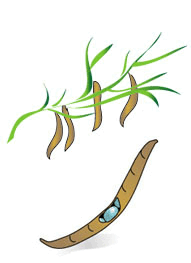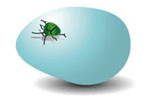Do you know who is feasting on the seed pods?
Phoenix is an expanding urban area located within the Sonoran Desert. Many trees are uniquely adapted to living here and they are part of food webs that include animals and insects who also are adapted to desert living.
One Sonoran Desert plant that has found its way into urban landscapes is the palo verde tree. In the desert, this tree supports a community of animals including bruchid beetles. These insects lay their eggs on palo verde seedpods and the larvae feed on the seeds.
Palo verde seedpods and beetles are connected
The interactions between plants and animals can provide vital information about the health of an ecosystem. Ecologists are interested in determining whether the interactions between urban palo verde trees and bruchid beetles is similar or different than their interactions in undisturbed Sonoran Desert communities.
You can provide important data by investigating the palo verde trees and bruchid beetle populations in your schoolyard.
Beetles/seeds study
What is feasting on those seed pods?
Bruchid beetles eat the seeds produced by palo verde trees. Palo verde trees are native to Arizona’s Sonoran Desert. They also are common in landscaped areas including parks, schoolyards and backyards.
Female bruchid beetles lay their eggs on palo verde seedpods. After they hatch, beetle larvae eat the seeds, pupate and emerge as adult beetles through little holes they create in the seed pods.
Why study them?
- Plants are at the base of food webs and any change in a plant community can have an impact on all organisms that feed higher up the food web.
- We don’t really know whether palo verde trees growing in a city have different seedpod development as compared to those in the Sonoran Desert.
- We also don’t know how (or even if!) urbanization of the trees has changed the interaction between bruchid beetles and palo verde trees.
- There might be many reasons that urban trees will grow differently than desert trees. For example, trees in yards and parks may receive more water and fertilizer which could increase the number of seeds produced.
What do they tell us about our urban ecosystem?
Whether or not a seed will be eaten by a beetle depends on many different things. If a female beetle finds a seed, it must lay an egg on it and then the beetle larvae must be able to eat the seed and survive. All these factors could be different in the city versus the desert. For example, the city seeds might be more or less attractive to the beetle, just as food prepared in different ways might be more or less appealing to you. Even if the beetle likes the seed the larva may not be able to survive feeding on it. For example a particular seed might be too small or too tough to eat.
CAP LTER ecologists are interested in the impact humans have had on native plants growing in cities and the insects that feed upon them. Your investigations might contribute to this understanding.
What materials will you need?
- Bags (paper, plastic)
- Data sheet
- Pencil
- Magnifying glass
Beetles/seeds protocols
Bruchid beetles and seed pods protocol
- Choose a site that has blue palo verde (Parkinsonia florida) trees. Make sure they are blue palo verde trees and not foothill palo verde (Parkinsonia microphylla) trees.
- Identify your collecting site as either desert or urban. Complete a habitat description data sheet for each site where you are collecting pods. You will need to do this before entering data into the CAP LTER database. YOU ONLY NEED TO DO THIS ONCE PER COUNT SITE.
- Collect 30 pods from each site. Pods should be collected directly from the trees.
- Collect five pods from six different trees. (If you cannot find six trees then collect an equal number of pods from each tree for a total of 30). Be sure to collect the five pods from different locations and different heights on the tree.
- Assign a number to each tree.
- Put all the pods from one tree in one bag. If you collect five pods from six trees then you will need 6 bags (one for each tree) and each bag will have five pods. Put a label in the bag with the site and tree number on it.
- Once inside your lab, examine each pod, give it a number.
- Count the number of bruchid beetle emergence holes. Bruchid beetle holes are round and 1-2 mm in diameter.
- Count the number of seeds each pod contains.
- Enter all the information on the data sheet.
Bruchid beetle life history
Blue palo verde tree with seed pods contents
Blue palo verde produces seeds that are attacked by three species of bruchid beetle: Stator limbstus, Mimosestes amicus and Mimosestes alkei. Blue palo verde trees bloom from late March to May and seed pods develop from May to June.

Female bruchid beetle lays eggs
Mimosestes amicus and Mimosestes ulkei lay eggs on the pod and the larvae burrow through the pod and into the seed.

Growing within seed
Stator limbatus enters the seed pod through emergence holes and lays the egg directly on the seed.

Larvae growth
Larvae take about 34 days to mature.

Adult bruchid beetle
Adult beetles emerge in September and October leaving round emergence holes in the seed pods.

Beetles/seeds identification key
An adult bruchid beetle has emerged, which species is it? Here is a key to the three bruchid beetles that feed on blue palo verde seed pods:

- 1a. Beetle is <3 mm in length, has orange “bean-shaped”* markings on the wing covers (elytra) Stator limbatus
- 1b. Beetle is larger than 2.5 mm in length, with no orange markings Go to 2
- 2a. Beetle has light (or white) stripe down center of wing covers (elytra) with black border along sides – giving the appearance of a tuxedo Mimosestes ulkei
- 2b. Beetle has brown, grey, or golden wing cover (elytra), with no stripe down center of back Mimosestes amicus
*sometimes this looks crescent-shaped or lobe-shaped
Beetles/seeds data
Record your data using the sheet outlines below. Do you need a data sheet to record your data? Choose a link below to get a printable data sheet.